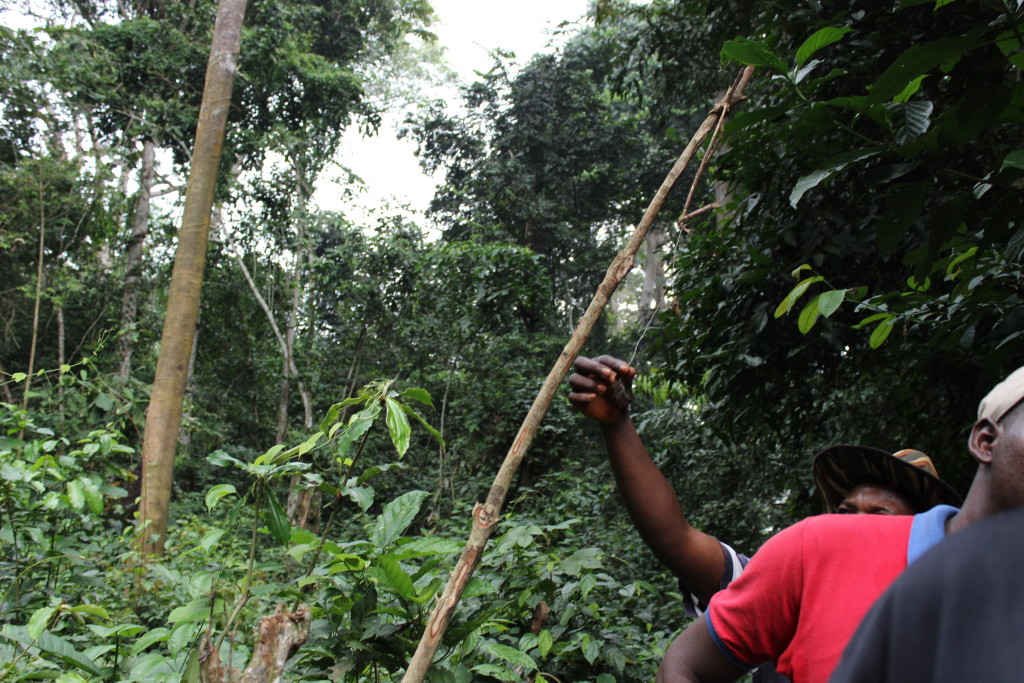Scenes from Équateur
Rambutans are a sweet fuit enjoyed by locals. Here, a bunch in the botanical gardens matures slowly. When ready, they will become reddish/pink.
The Botanical Garden of Eala was opened in 1900 by Emile Laurent, a botanist of King Leopold II of Belgium.
Coffee was also once widely produced for export in the DRC. Now locals cultivate it mostly for their own personal use.
Small-scale deforestation is most common in Équateur, as farmers need fertile forest soil to grow crops.
Because of poor road maintenance and the high cost of vehicles, bicycles are often the main source of transport from the village to the city. These bicycles are stacked high with palm oil, which will hopefully fetch a higher price closer to the city.
Agronomist Robin Brunet checks on his cooking bricks, which create quite a lot of heat, especially on an already warm equatorial day.
Croton, or Rushfoil, is a popular houseplant around the world, but grows vigorously in the Botanical Garden.
Overfishing is a huge threat to the fish populations of Équateur. The locals pride themselves on having unique, tasty species, but many of these are at risk due to a growing population and newer, more efficient fishing methods.
The Congo River is vast, filled with small islands and floating vegetation. At its widest point it is over 7 miles wide.
Charcoal is in huge demand in cities, as most in the DRC have limited access to other energy sources. Here, charcoal is being produced on a float, which will travel all the way downstream to Kinshasa to be sold at high prices.
The Congo River is the main way to transport goods between Mbandaka and Kinshasa. Here, a beer barge is docked for the night.
Like most places in the world, often times thank yous are accompanied by gifts. Here a chicken is tied up securely before being given to Dr. Bush.
Although commercial logging is not widespread in the DRC, “artisinal” logging is allowed in certain instances.
A tour of the forest surrounding Bokumu Mokola took Dr. Bush and Dr. Walker through several kilometers of primary and secondary forest.
Traps are an effective way of catching animals in the forest, and are often used to snare wild pigs.
Living in Équateur is not always easy–here Dr. Walker and Dr. Bush attempt to install a pump in the well outside.
Corn is more commonly eaten in the northern part of the province, either ground into flour or grilled–perfect served with mutton.
Caterpillar trees are easy to spot as they lose their leaves at a different time of year than other trees around them.
The DRC is the number one consumer of cassava in the world. However, this tubular root must be carefully processed before it is eaten as it contains cyanide.
This chameleon was found by a child during Project Équateur’s visit to a pilot village–a sign of luck!
Project Manager Melaine Kermarc, with the help of agronomist Robin Brunet, has managed to lure some bees into the tree next to the office.
Palm oil was once widely cultivated in Équateur, however most plantations are now untended. There is great potential for sustainable palm oil production in the DRC which would rehabilitate these lands instead of cutting down primary forest.
Caterpillars prefer certain trees, and can be found in huge quantities during certain times of year.
Caterpillars are a popular meal in the DRC–these caterpillars were gathered in the northern forests. Some will be eaten and many will be sold for additional income.
Although commercial logging is not widespread in the DRC, “artisinal” logging is allowed in certain instances.
Sandalwood has a reddish hue, and is used by many to treat skin inflammation and other skin problems.
Livestock is often allowed to roam free in Équateur, which can be damaging to crops and land if not properly attended to.
REDD+ Provincial Focal Point Joseph Zambo and staff from the Botanical Garden of Eala discuss the best location for carbon plots in the botanical gardens.
Most fuelwood is gathered by women, who tend to collect deadwood as opposed to cutting new trees. This work is time consuming and a growing population forces women to travel farther and farther each year in search of suitable wood.
Project Manager Melaine Kermarc talks to villagers from Buya 1 about forest resources and climate change.
Many of the fruits of Équateur are, although tasty, unknown to the rest of the world. This fruit is sweet, and it is called the “Cardinal’s Hat”, after the unique headwear of Catholic Church officials.
As Bokumu Mokola is fairly isolated due to the forest and poor roads, many children do not often meet foreign visitors.
Forests are often cut to provide a fertile place to grow manioc and corn. Here a banana tree has also been planted.
The Projet Équateur team was welcomed into a seasonal forest home during a downpour in the forest. For lunch? Cassava and dried caterpillars with peanuts.
African Grey Parrots are indegenous to Équateur and highly endangered. This cative parrot lives in a monastery in Gemena.
Although papaya grows freely, much of the fruit is not harvested, as it is considered a food for children or the poor.
Dr. Walker shows Dr. Bush how he can mark this deforested plot on his GPS so that he can compare it to satellite images later on.
The white pulp that covers the cocoa bean is sweet to the taste–much better raw than the bitter bean that is beloved by so many around the world.
Photos by Eva McNamara
















































































